Allen Tiller's Blog, page 20
February 16, 2021
It's Only a Bastard.
In 1878, Mary Scudmore was charged with unlawfully beating Charles Grills, a nine-month-old child.
Scudmore appeared at the Police-court before Judges Beddome, Wilshire and Reed. The prosecutor read the charge that Scudmore was accused of cruel conduct towards the child.
It was claimed that on several occasions she had thrust the child’s head into dirty water to get it to stop crying, almost drowning the boy. It was stated that if anyone confronted her about her cruel behaviour she would state; “It’s only a bastard. There’s no such luck as killing it. The child has got as many lives as a cat!”.[1]
Scudmore’s neighbour reported her to the police. The child had been in Scudmore’s custody for an unknown amount of time. The Judges deliberated among themselves and came back with the verdict ‘case dismissed’ on the grounds that the evidence fell short of what required to prove the charge.[2]
[1] 'MONDAY, OCTOBER 14.', South Australian Chronicle and Weekly Mail, (19 October 1878), p. 13., http://nla.gov.au/nla.news-article92265724
[2] 'Law and Criminal Courts.', Evening Journal, 914 October 1878), p. 2., http://nla.gov.au/nla.news-article197...
February 9, 2021
Thomas Cunningham: Rogue and Vagabond (Part II)
Thomas Cunningham: Rogue and Vagabond (Part II)
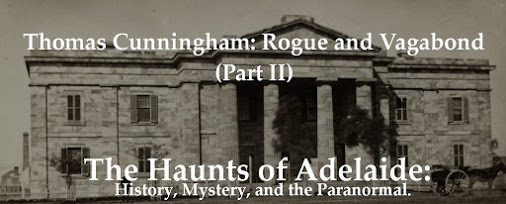
After serving two years in gaol for the abduction of 15-year-old girl Ellen Ween, Cunningham found himself living on Currie Street at Boddington Row in the company of a prostitute, Alice Tree. The pair were accused of unlawfully and maliciously wounding Ah Kong, a charge later dismissed.
Thomas Cunningham found himself in further trouble in 1882 when he faced court on the charge of being a ‘Rogue and Vagabond’. The charges were brought forth by Detective Dunlevi, who stated for the prior twelve months, Cunningham was unemployed and had been associating with thieves and prostitutes. He had served two years for abduction and had prior to that been charged and convicted for larceny, felonious assault, and assaulting police.
Cunningham told the court he would find work on Wednesday. Sitting Judges, Beddome and Lucy allowed him to be released to do so.[1] Cunningham did not look for work, instead, he went about his usual business, drinking and gambling at the Shamrock Hotel, the Ship Inn, The Provincial Hotel, and the Galatea Hotel. Detective Hampton arrested Cunningham and again charged him as a Rogue and Vagabond.
On 22 May 1882, Cunningham was brought before Judge Beddome. This time the Judge was not so lenient, sentencing Cunningham with two months imprisonment and two sureties to keep the peace at 50 pounds each.
Cunningham was the charged with assaulting Police Officer Copeland. Officer Copeland stated that while trying to arrest Cunningham for the charge he sat previously, Cunningham turned and struck him in the eye. Judge Beddome sentenced Cunningham to a further six months in prison and hard labour.
Another man Edward Bates was charged alongside Cunningham, for inciting Cunningham to resist arrest. He was fined 1 pound and two 50-pound sureties to keep the peace for a year.
Yet another man, William Jury, was sentenced for assaulting police. Jury had seen the Constable arresting Cunningham and starting remonstrating with him to release Cunningham, in doing so, he kicked the officer several times. Jury was sentenced to six months in prison.[2]
Researched and written by Allen Tiller © 2020
[1] 'Adelaide: Monday. May 1.', Adelaide Observer, (6 May 1882), p. 12., http://nla.gov.au/nla.news-article160....
[2] 'MONDAY, MAY 22.', South Australian Weekly Chronicle, (27 May 1882), p. 13. , http://nla.gov.au/nla.news-article914...
February 2, 2021
Thomas Cunningham: Rogue and Vagabond (Part I)
Thomas Cunningham: Rogue and Vagabond (Part I)
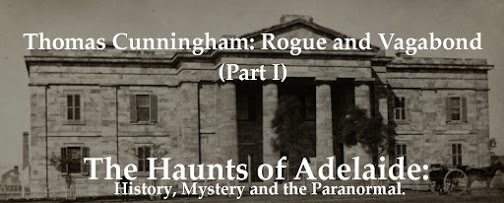
You may remember Thomas Cunningham from my previous blog, ‘The Colourful and Tragic Life of Alice Tree: Part 1 - “Kill the Chinaman!”’. Thomas was then the partner of Adelaide prostitute Alice Tree, and was accused of unlawfully and maliciously wounding Ah Kong, a charge later dismissed. Before that incident, Cunningham had served a two-year sentence in gaol for abduction.
In 1877, Thomas Cunningham was charged with attempting to abduct 15-year-old Ellen Ween. On 14 October the same year, Cunningham who been lodging with the Ween family at Nailsworth had become acquainted with young Ellen, and fallen in love with her.
Thomas and Elizabeth Ween, Ellen’s parents were mortified that Cunningham, a married man, would dare to try and corrupt their daughter. Cunningham replied to Mrs Ween that if he couldn’t have her daughter one way, he would have her another.
On 14 October, Ellen asked to go out. She never returned. Mrs Ween saw Cunningham on the 15th and asked him about her daughter. He said he would be leaving and wanted nothing to do with the Ween family any longer.
Cunningham and Ellen were discovered at Rochester, near Clare, by Police Trooper Atkinson on 8 December. Cunningham gave Atkinson a fake name Thomas Bane, Ellen was gathering wood on a hill, but soon returned to Cunningham’s tent. Atkinson queried them, with Cunningham saying he did not run away with the girl, she came freely with him and paid her own way.
Ellen said to the Trooper that she would go wherever Cunningham went, that he did not take her away, and that she would “never go borne again because she would be sent to the Industrial School.”
Ellen said she was afraid to go home as her father had threatened her and Cunningham with a knife, then threw it at them. She told her mother she was going out with a servant girl and ran away. Her mother found her, however, and told her to return home, where she would “keep her in”. To this Ellen replied that her mother “would not keep her in, or the Governor either,” Ellen’s father came looking for her, so she fled north.
During the trial, Ellen Ween was questioned by the prosecution about her abduction. She replied she had not been abducted but had asked a carter to tell Thomas Cunningham she wanted to see him. She claimed she that Cunningham declined to go away with her, but when she said she would pay her own way to Burra, he consented. Ellen stated that she knew Cunningham was a married man, but she did not care. Ellen also accused her mother, with impudence, of giving her a black eye.[1]
Elizabeth Ween was called to the stand. She stated to Cunningham; “Yon left our house because we would keep you no longer. My husband did not run after my daughter with a knife and threaten to stab you.” John Ween added, “I have never beat my daughter in my life. John Ween, “she was taken away without my consent.”
Ween also stated he had never thrown a knife at the girl.
Mr Smith, who conducted the prosecution for Superintendent Peterswald, produced the register of the birth of the first Ellen Ween, who died on December 9, 1862, six months after the present Ellen Ween was born. Search for the certificate of birth of the surviving Ellen Ween was being made.[2] Detective Doyle discovered Ellen Ween’s birth registry entry proving she was just 15 years old. Cunningham was remanded in custody until his trial in March the following year.
At the Supreme Court, the Judge declared he was glad he had made the decision to take the case into consideration, so as to relieve his own feelings of disgust about the matter. The Judge stated that the evidence showed that Cunningham, a married man, did not have it in his power to undo the damage he had done to the girl. He declared that Cunningham’s conduct in the court was disgusting. Thomas Cunningham was found guilty of abduction and sentenced to two years hard labour in gaol.[3]
Next Week: Thomas Cunningham: Rogue and Vagabond (Part II)
Researched and written by Allen Tiller © 2020
[1] 'TUESDAY, DECEMBER 11.', South Australian Chronicle and Weekly Mail, (15 December 1877), p. 13., http://nla.gov.au/nla.news-article909....
[2] 'POLICE COURTS', Adelaide Observer, (15 December 1877) p. 7. http://nla.gov.au/nla.news-article159...
[3] 'LAW COURTS. SUPREME COURT—CRIMINAL SITTINGS', The Express and Telegraph, (27 March 1878), p. 2., http://nla.gov.au/nla.news-article207...
January 19, 2021
The Colourful and Tragic Life of Alice Tree: Part 2 - “Riotous Behaviour and Death.”
The Colourful and Tragic Life of Alice Tree: Part 2 -
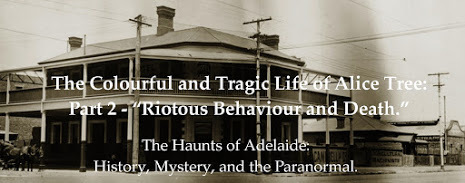
Alice Tree was certainly no angel, her long list of crimes, mainly theft and prostitution, made her an easy target for police patrolling the notoriously seedy area around the Shamrock Hotel in north-west Adelaide. Light Square, Currie Street, Rosina Street and Elizabeth Street were all known hotspots for opium dens, prostitution, and other serious crimes.
In 1875, Alice Tree was fined 20 shillings for loitering with her friend Matilda Lattin.[1]
November 1878, 21-year-old Alice Tree and 23-year-old Francis Major are found guilty of stealing 19 pounds from Robert McKinnon at the home of W.R. Evans.[2]
January 1879, Alice Tree, Annie Kelly, and Mary Ann Young were charged with behaving in a riotous manner in Light Square but were acquitted.[3]
October 1879, Alice Tree, Georgina Aslee, and Mary Minchin were charged with riotous behaviour while in a cab. Fined 10s each.[4]
November 1879, and Miss tree and her cohorts find themselves in trouble with the law once again. This time Alice Tree, Elizabeth Hillman and Elizabeth Alderson was charged with ‘riotous conduct in a public conveyance in Rundle Street’, the ladies were fined 10s each. Another young lady, in the company of the three women, Mary Ann Gearing was fined 10s for indecent behaviour at the same hearing.[5]
In January 1880, Alice Tree with charged with stealing the pocket watch of Francis Major. At court, Major stated he got out of gaol on December 27th, 1879 and met Tree at the Phoenix Hotel. Tree stole his watch, but he later went home with the prostitute. The court dismissed the case.[6]
On 9 November 1882 Constables Lucas and Donahue were walking the beat in Adelaide. The police officers were walking down Currie Street when they stopped at the house of known prostitute Alive Tree. Through Tree’s window at Boddington’s Cottages, they could see a man holding Tree with one hand, while his other hand was raised in a fist about to strike her. The man said to Tree. “Stop it now, or I’ll do for you yet!”[7]
Donahue called out to the man to stop what he was doing. The argument stopped for a few minutes but commenced again. Again, Donahue called out to the man to stop. The man replied, “it’s all right bobby,” and the fighting stopped. The constables waited ten more minutes, and as the fighting had stopped, continued walking their beat.
On 10 November 1882, Constable Holmes was on duty at the Light Square police station when he was called to attend an address on Currie Street. When he arrived, he found Constable Pascoe in attendance at the home. Pascoe and Holmes then inspected the body the naked Alice Tree, who was lying on her bed, dead, but still warm.
They inspected her body under candlelight and discovered bruising on her face and other areas of her body. A woman from across the street spoke to the police and told them she had seen a man strike the woman with a glass and a bottle.
When Constable Pascoe had arrived, Henry Page, who lived with Tree, had run off to find a doctor. He did not return. Constable Holmes went in search of Page and found him in Morphett Street. Page told him he had gone in search of a doctor, tried three, but none would come back to Currie Street with him. Holmes took Page into custody and took him to the Light Square station and made a report, he then returned to the Currie Street address with Detective Burchell.
The detective found broken chairs in Tree’s room. There was dried blood on the wall near where Tree and Page had been arguing the night before. Several towels and handkerchiefs were found soaked with blood. Other blood-stained items were found throughout the house, as well as broken bottles and glass covered with blood.
Dr Melville R.H. Jay was called upon to conduct a post-mortem examination on the body of Alice Tree at the Destitute Asylum. Jay discovered bruising on the face, left breast, shoulder, arm and forearm. He could find no external signs of injury on her head but found a large blood clot covering the left side of her brain.[8]
During an inquest into the death, witnesses were called. Thomas O’Neil had been drinking at the house on the Friday in question with Henry Page and another woman. Page told him that he and Tree had been fighting the night before. O’Neil had seen Tree lying in her room, and figured she was asleep. He had tried to wake her, but she did not move, so he told Page to go get help.
the next witness was Tree’s friend Petrea Larsen. Larsen had seen Tree after she had been beaten by Page and tried to reduce the swelling on her eye. Larsen declared that she had previously heard Page say to Tree that he would kill her before her ex-partner, Cunningham, got out of gaol.
Emily Harris, who also shared the house with Tree and Page, deposed that she had seen Page throw Tree against a hard, wooden box on the floor. She also stated that Tree had told her, that Page had previously beaten Tree down, then jumped on her as she lay on the floor.
A neighbour, Maude Wenden gave evidence that she had seen Page strike Tree on the nose, but it had not knocked her down. She put forward that Tree aggravated Page, implying she deserved the treatment. Wenden had heard a woman’s scream on Friday morning at about 11:30 am. She checked on Tree, but saw her laying on her bed asleep, so let her be.
The jury delivered the verdict; “That the deceased, Alice Tree, came to her death through injuries received from the ill-treatment of Henry Page and they found Henry Page guilty of manslaughter.[9]
On 15 December 1882, Henry Page was brought before the South Australian Supreme Court charged with manslaughter. Page, who had no lawyer, pleaded not guilty to the charges. Evidence was presented by the police prosecutor, including a statement by O’Neil, who failed to show up to the hearing. Evidence from Ah Kong was put forward, that he had heard O’Neil at the previous inquest hearing, state to Page that he need not fear the hearing, as he would not speak of what he had seen.
The Judge asked Page if he would like to give evidence, but told him if he was sworn in, he would be cross-examined. Page opted to offer a statement instead; denying he had ever struck Tree with any weapon and protesting that he did not inflict the wounds that killed the 25-year-old woman.
The Jury, on the advice of the Judge that the evidence was insufficient that Page had caused the death of Alice Tree delivered a verdict of Not Guilty. Page was discharged and allowed to go free.[10]
[1] 'THIS DAY.', The Express and Telegraph, (19 November 1875), p. 2., http://nla.gov.au/nla.news-article208....
[2] 'LAW COURTS.', The Express and Telegraph, (13 November 1878), p. 2. http://nla.gov.au/nla.news-article207....
[3] 'POLICE COURTS.', South Australian Register, (30 January 1879), p. 1., http://nla.gov.au/nla.news-article429....
[4] 'LAW COURTS. POLICE COURT—ADELAIDE.', The Express and Telegraph, (4 October 1879), p. 2., http://nla.gov.au/nla.news-article207....
[5] 'POLICE COURTS.', South Australian Register, (1 November 1879), p. 1., http://nla.gov.au/nla.news-article430....
[6] 'TUESDAY, JANUARY 6.', South Australian Chronicle and Weekly Mail, (10 January 1880), p. 22., http://nla.gov.au/nla.news-article950....
[7] 'CORONER’S INQUEST.', Evening Journal, (13 November 1882), p. 2., http://nla.gov.au/nla.news-article197....
[8] ‘LATE TELEGRAMS.', Kapunda Herald, (14 November 1882), p. 3., http://nla.gov.au/nla.news-article106570341.
[9] 'DEATH UNDER SUSPICIOUS CIRCUMSTANCES.', South Australian Weekly Chronicle, (18 November 1882), p. 7., http://nla.gov.au/nla.news-article931....
[10] 'SUPREME COURT - CRIMINAL SITTINGS.', South Australian Register (16 December 1882), p. 2.http://nla.gov.au/nla.news-article433...
January 12, 2021
The Colourful and Tragic Life of Alice Tree: Part 1
The Colourful and Tragic Life of Alice Tree: Part 1
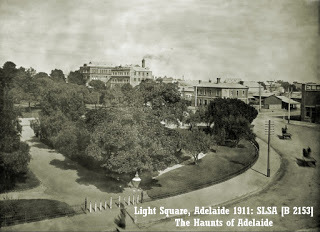
Alice Tree was a prostitute working from Boddington Row in Adelaide’s West End. Boddington’s Row was a small group of cottages alongside the Shamrock Hotel (Colonel Light Hotel) that Thomas Boddington, owner of the Shamrock Hotel leased at inflated prices to prostitutes who frequented his hotel.
July 1881, Alice Tree and her partner, Thomas Cunningham, a labourer, was arrested by police on the evidence of Ah Kong, that Cunningham had maliciously wounded him.
Ah Kong had sold a jacket to Alice Tree, he went to her house on Currie Street to collect his payment. Cunningham opened the door to Kong, but would not let him inside, saying to Kong, “I will come out and kill you.”
Cunningham then rushed at Kong and punched him in the face. Tree then rushed outside and struck Kong over the head with a pot stick, knocking him unconscious to the ground.
A passing police constable noticed Kong on the ground a little while later and sent him to the hospital where he was treated. Once he gained consciousness, Kong told police what had happened.
Detective Webster arrested Cunningham and Tree on Clarendon Street. Cunningham said to Tree, “I suppose we shall be committed for this, Alice”. The two prisoners made no further statements and were bailed at court, on the surety of 50 pounds each, and two others in 85 pounds each.
Cunningham and Tree appeared in court in August charged with unlawfully and maliciously wounding Ah Kong on 9 July 1881. Ah Kong, on the witness stand, gave an entirely different account of what happened on the day.
Kong stated that Alice Tree owed him money for drapery, so he went to her house to ask for the goods back. Cunningham was there and told Tree to stay inside. He claimed Cunningham used threats and bad language, then Tree hit him with a stick shouting “Kill the Chinaman!”
Kong claimed he fell to the ground and Cunningham seized him by the throat, and asked Tree for a knife, with the intentioned to slit his throat, that was when Tree struck Kong over the head.
He claimed another man came to his rescue, and as he (Kong) escaped, he fell to the ground unconscious, only to wake up in the hospital.
At this point, Kong was stopped and examined. It was revealed that Kong had arrived at Tree’s house brandishing a tomahawk and threatened to use it if Tree did not pay him.
The Police Court decided that as Kong's evidence could not be relied upon, that the case should be dismissed. The Judge agreed and acquitted them both.
Next week:
The Colourful and Tragic Life of Alice Tree: “Riotous Behaviour and Death.”
Researched and written by Allen Tiller © 2020
[2] 'Law and Criminal Courts.', Evening Journal, (13 July 1881), p. 2., http://nla.gov.au/nla.news-article197....
[3] 'LAW COURTS. SUPREME COURT—CRIMINAL SITTINGS', The Express and Telegraph, (4 August 1881), p. 2., http://nla.gov.au/nla.news-article208....
November 17, 2020
The Haunted Boy
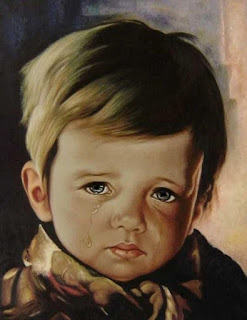
Recently I have seen for sale in Adelaide several the old allegedly cursed “Haunting Boy” paintings, so I thought why not write about that, and get to the bottom of the legend!?
In 1985, ‘The Sun’, a very popular tabloid newspaper in England, published a story in its September 4th edition (page 13) with the Headline “Blazing Curse of the Crying Boy”. The story that followed told how, after a fire burnt their South Yorkshire’s home to the ground, married couple Ron and May Hall put the blame squarely on a picture of a crying boy they had hung in their home.
A fire broke out from an overheated frypan of oil and devastated the home they had lived in for 27 years, the house was a mess, and one of the only things unscathed in the fire was a picture of crying toddler, hanging on a wall. Ron’s brother Peter, was a local fire-fighter, his Fire Station leader, Mr Alan Wilkinson said he had heard of numerous cases of fires where prints of “crying boys” would be undamaged in a devastating house fires, this of course turned a mundane ‘hot chip’ fire story into a leading headline, and propelled the “Crying Boy” curse into the world spotlight.
The story picked up legs in the next day’s edition, when The Sun reported that readers had been phoning in with their own horrifying stories of bad luck related to The Crying Boy paintings. Quotes were printed in the newspaper such as this one from Dora Mann in Surrey “All my paintings were destroyed – except the one of The Crying Boy”.
A Mr Parks claimed he had destroyed his copy after returning from the hospital from smoke inhalation from his house burning down, to find the only thing untouched in the scorched ruins was a crying boy painting.
More stories accumulated, about misadventures happening to residents in houses where the prints hung. One lady even speculated that the painting may have been the cause for her husband and three sons dying over a span of a few years.
A security guard named Paul Collier threw one of his two prints on a bonfire to test the theory that the paintings and prints would not burn, he claimed that after an hour in the flames, the painting was not even scorched, this of course led to even more sales for The Sun!
Strangely, not all the prints and paintings were of the same crying boy, paintings by Giovanni Bragolin and Scottish artist Anna Zinkeisen became associated with the Curse. Zinkeisen had released her crying boy paintings as part of a study titled “Childhood”.
After some time (and a lot of newspaper sales) it emerged that Alan Wilkinson had personally logged about 50 “Crying Boy fires dating back to 1973”. He had dismissed any supernatural connection between the fires and the paintings, finding that in almost every case, it was human error, or human carelessness that had started the fire. He could not explain though, why the paintings would survive the fires unscathed.
As the original sun newspaper story began to fade from readers’ minds, the story of the Crying Boy paintings morphed into an urban legend and spread across the world. Along the way new information was added to the original legend; psychics claimed a spirit was trapped in the original painting, and the fires were an attempt to free itself. Other stories told how the artist’s bad luck had cursed the painting, and that’s why so many bad things happened in its presence.
The Crying Boy legend is still very much alive today, recently shown on the new TV series “Cursed”. If one looks hard enough one can find enough evidence to suggest that this whole urban legend is an exaggerated coincidence designed by The Sun Newspaper back in 1985 to sell newspapers, now it has become part of urban legend and pop-culture.
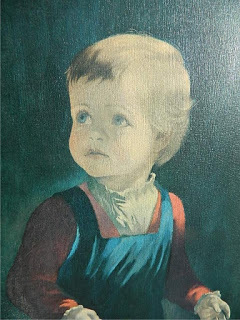 Anna Zinkeisen's version of the crying boy
Anna Zinkeisen's version of the crying boy
Allen Tiller is Australia’s most recognised paranormal investigator, eminent paranormal historian, and star of the international smash hit television show “Haunting: Australia”.
Allen is also the founder of Eidolon Paranormal, South Australian Paranormal and the author of book and blog, “The Haunts of Adelaide: History, Mystery and the Paranormal”.
Allen was awarded the 2017 “Emerging South Australian Historian of The Year Award” as presented by The History Council of South Australia.
Allen has also been employed as “Historian in Residence” in 2016/2017 with the Adelaide City Council Libraries and employed by the City of Port Adelaide Enfield Council to write the
popular, “Ghosts of the Port Self Guided Walking Tour”
www.twitter.com/Allen_Tiller
www.facebook.com/AllenHauntingAustralia
https://www.facebook.com/TheHauntsOfA...
First published in MEGAscene Issue 8 2016
November 10, 2020
The Ghosts of the Ambassador Hotel
King William Street, Adelaide
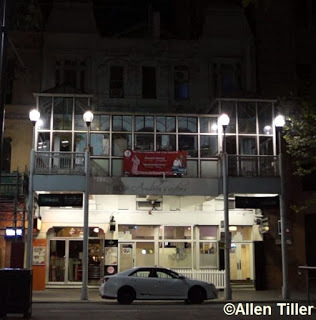
It is claimed the Ambassador Hotel is haunted by a former employee named Mary. There has long been the insinuation that room 103 is allegedly haunted by Mary’s spirit, but after interviewing staff in 2016 for the Haunted Buildings in Adelaide library project, that story can now be amended.
Staff claim Mary haunts the dining room and is known to set up table service and do the
dishes! It is thought Mary is a former employee who started work at the hotel at the age of 15, living on site. She died at the age of 93 in the hotel and has been helping staff ever since!
Mary is not the only ghost haunting the Ambassador Hotel, another alleged spirit is that of John Gray,
who died when a previous hotel on the same site was demolished. Mr Gray was crushed by a falling wall and is now alleged to haunt the basement.
Room 11 is thought to be haunted by a man named James Wilson who died in the hotel in 1890. Another as of yet unidentified ghost is seen upstairs from time to time in a number of different bedrooms, drifting from room to room as if in search for someone or something.
Allen Tiller is Australia’s most recognised paranormal investigator, eminent paranormal historian, and star of the international smash hit television show “Haunting: Australia”.
Allen is also the founder of Eidolon Paranormal, South Australian Paranormal and the author of book and blog, “The Haunts of Adelaide: History, Mystery and the Paranormal”.
Allen was awarded the 2017 “Emerging South Australian Historian of The Year Award” as presented by The History Council of South Australia.
Allen has also been employed as “Historian in Residence” in 2016/2017 with the Adelaide City Council Libraries and employed by the City of Port Adelaide Enfield Council to write the
popular, “Ghosts of the Port Self Guided Walking Tour”
You can find Allen online at:
www.twitter.com/Allen_Tiller
www.facebook.com/AllenHauntingAustralia
https://www.facebook.com/TheHauntsOfA...
First published in Megascene issue 16 2019
November 3, 2020
A Haunting at the Corio Hotel, Goolwa
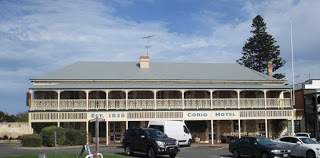
The Corio Hotel, Goolwa was built in 1857. It is named after the paddle steam-ship Corio, which sank on the nearby Murray River in 1857. The Corio Hotel license was approved in 1850 and issued to William Ray on March 31st of that year.
The Corio Hotel also has adjoining shops that are part of the hotel complex. The shops have been used as a saddler shop, blacksmiths, a general store and a barber.
The Corio Hotel in Goolwa was alleged to be haunted by a female ghost who hates other women. It is claimed that this spirit once held a woman down on a toilet when she tried to stand up after finishing her business. The woman stated that as she tried to stand up after using the toilet, she felt a strong hand force her back down.
She freaked out as no-one was in the cubicle with her, or in the toilet at all. Suddenly the hand let go, and she shot out of the toilet into the hotel and ran out through the front door, only to tell her story later when she had calmed down.
A ghostly woman was witnessed in the Corio Hotel in 1977 by staff member Gary Crouch who described her in a witness statement as; “A short woman with grey hair that had a bluish tinge. She was wearing a dress that hung down loosely over her knees.”
Gary and his boss saw the ghostly woman head toward the female’s toilets from the central games room. Thinking it was a person locked in after closing, the two men went to ask her to leave, only to find no living soul in the women’s toilets. The men checked the rest of the hotel, which had been locked up for closing, to find nobody other than themselves inside!
The ghostly presence isn’t just centred on the women’s toilets, it is also known to go about its business in the men’s! Male patrons have reported toilet rolls spinning at incredible speeds of their own volition.
Other witnesses have seen the ghostly woman standing at the front bar, when staff have turned to serve her, she has vanished. The temperature in the room is also said to drop dramatically in the apparition’s presence.
There once stood a blacksmith at the rear of the hotel, which today is part of the bottle-shop. A
bottle-shop worker once witnessed the apparition of a man walk through a wall, where once there was a door, and off through the car park, through a fence, disappearing as he crossed a road.
Allen Tiller is Australia’s most recognised paranormal investigator, eminent paranormal historian, and star of the international smash hit television show “Haunting: Australia”.
Allen is also the founder of Eidolon Paranormal, South Australian Paranormal and the author of book and blog, “The Haunts of Adelaide: History, Mystery and the Paranormal”.
Allen was awarded the 2017 “Emerging South Australian Historian of The Year Award” as presented by The History Council of South Australia.
Allen has also been employed as “Historian in Residence” in 2016/2017 with the Adelaide City Council Libraries and employed by the City of Port Adelaide Enfield Council to write the
popular, “Ghosts of the Port Self Guided Walking Tour”
You can find Allen online at:
www.twitter.com/Allen_Tiller
www.facebook.com/AllenHauntingAustralia
https://www.facebook.com/TheHauntsOfA...
First published in Megascene issue 16 2019
October 27, 2020
The Adelaide Ghosts and Ghouls and Walking Tour
Back in 2016, I was invited by the Adelaide City Libraries to undertake a world fist
history study into ghosts and hauntings in the council area of the City of Adelaide. Titled “Haunted Buildings in Adelaide”, the project encompassed inviting members of the public to come into the City Library and North Adelaide Library to express their own personal encounters with ghosts in the City of Adelaide.
I then took those stories and investigated them, as well as a number of already well known Adelaide ghost stories, and investigated their history. In the first year, we had over 90 people attend, and at least 40 of those stories ended up being added to the libraries catalogue under the heading “The Allen Tiller Collection: Haunted Buildings in Adelaide”.
In 2017 I returned to the library to turn those stories, and some new ones into 5 self-guided walking tours through the City of Adelaide.
At the end of history month this year, we launched one of those tours, titled the “Ghosts and Ghouls and Self-Guided Walking Tour”. The difference between this tour, and other tours, is the City Library invited a professional sound recordist, Mr Anthony Frith, to record me speaking the tour stories.
The tour is a downloadable, free self-guided walking tour which you can find via this link:
https://www.cityofadelaide.com.au/exp...
 The tour starts at the City Library, so I thought I’d share with you all the starting story of the tour: A Ghost in the Library Harris Scarfe’s city store sat on this site previous to the current Rundle Place building.
The tour starts at the City Library, so I thought I’d share with you all the starting story of the tour: A Ghost in the Library Harris Scarfe’s city store sat on this site previous to the current Rundle Place building.The Harris Scarfe’s building was constructed in 1917 and, in an unfortunate accident, a concrete worker fell into the foundations as they were poured. He was sucked down into the mix, suffocating, and crushing him at the same time. It was deemed too difficult and risky to save the worker, and after the concrete had set, too expensive and labour intensive to remove his body – so he was left in the foundations.
In 2012, McMahon Services was engaged to demolish the previous building and construct the new one you see today. As part of their plan, they decided to recycle as much of the original building materials as possible.
The old steel, glass and concrete were stored, crushed or melted, and reused in the construction of the present building. Including the concrete in which the worker had died.
So the remains of that worker, that was previously in the foundations, can possibly be found across the entire building today, and perhaps, that explains one of the hauntings associated with the building … but perhaps, more interesting, and relative to the city library is another more modern death.
In the 1970s, Harris Scarfe’s had a sports section on level three, and within that section was a department selling guns. In 1975, a man entered the store, went to the gun counter and asked to look at a gun. He loaded it with his own bullets, then in front of staff and customers, put the barrel
against his head, and shot himself dead.
The store was on level three, the same level that the City Library now sits on. Is it a coincidence that a black shadowy figure is sometimes reported whisking along the hallways towards the elevators today, in the general vicinity that a black shadowy figure was seen whisking along aisles when Harris Scarfe’s stood here previously?
Lifts are also said to be haunted in Rundle Place, just as they were reported haunted in the old Harris Scarfe’s building. Are the ghosts that haunted the former building, lingering in the new building?
In an interview in the Advertiser in 2011, a former employee of Harris Scarfe’s named Rod stated the following:“I’ve been here at two o’clock in the morning, by myself, and the goods lift would start-up and just go by themselves,” “You’d see them drop to the second flor, you’d hear the door open, you’d hear footsteps and then the lift comes back down to the basement and you’re thinking ‘well, I know I’m the only one here’.”
You can find the City Library at Level 3, Rundle Place, Rundle Mall (Enter via Francis
St - off Rundle Mall or via Da Costa Arcade) The Adelaide Ghosts and Ghouls Walking
Tour, a different way of seeing Adelaide!
Allen Tiller is Australia’s most recognised paranormal investigator, eminent paranormal historian, and star of the international smash hit television show “Haunting: Australia”.
Allen is also the founder of Eidolon Paranormal, South Australian Paranormal and the author of book and blog, “The Haunts of Adelaide: History, Mystery and the Paranormal”.
Allen was awarded the 2017 “Emerging South Australian Historian of The Year Award” as presented by The History Council of South Australia.
Allen has also been employed as “Historian in Residence” in 2016/2017 with the Adelaide City Council Libraries and employed by the City of Port Adelaide Enfield Council to write the
popular, “Ghosts of the Port Self Guided Walking Tour”
You can find Allen online at:
www.twitter.com/Allen_Tiller
www.facebook.com/AllenHauntingAustralia
https://www.facebook.com/TheHauntsOfA...
First published in MEGAscene issue 13 2018
© Allen Tiller
October 20, 2020
Mendelsham Robe Terrace Medindie
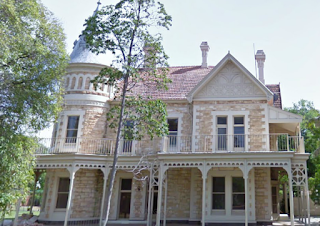
Designed by iconic South Australian architect; John Quinton Bruce for Fred Scarfe, A Director of South Australian department store icon, Harris Scarfe’s, ‘Stonehenge’, as the building was named, is a beautiful building located just north of Adelaide on Robe Terrace at Medindie.
Often it is reported that Frederick Norman Scarfe, former Mayor of Kensington and Norwood is the man who had the building erected, but by the time it was built, Frederick was a very old man. Frederick George Alexander Scarfe is the man who built the impressive house, he was a director of Harris Scarfe’s at the time, and a very wealthy individual.
The building consists of 15 main rooms and includes a gracious reception hallway and a sweeping grand staircase. There is also a ballroom, a formal lounge-room, a library and a formal dining room, plus five bedrooms and a wine cellar.
The house was often featured in local newspaper stories as Mr Scarfe would host events at his home. Scarfe was well known for throwing grand balls and parties, in which Adelaide’s elite would gather.
In 1919 Frederick Scarfe sold the house for an impressive sum, citing in advertisements that he found the housekeeping tasks laborious, with it being such a large manner. Scarfe was not keen on paying maids or cleaners.
During the 1930s the home was owned by and lived in by Mr Ernest Jolly, his wife Evelyn and two sons, Derek and Dennis. Jolly was a well-known for importing and racing thoroughbred horses. The Jolly’s were high-society members, and their functions were often reported in local newspapers.
In 1994, The Adelaide Advertiser (April 24th, 1994) published a story about the house featuring a local businessman, Tony Syrianos, who had purchased the manor for $1.2 million dollars. After the purchase, the businessman out that the house is haunted by a young lady.
The spirit of the young lady appears in an upstairs bedroom known as the Blue Room. It has been stated that she only appears during the hours of 11pm and 5am. She is said to walk from the Blue Room, to a bathroom, sometimes with the variation of walking up or down the extravagant staircase. She is dressed in a white nightgown with an overly frilly neckline.
The haunting of the Robe Terrace Manor (called Mendleshamon the show) appeared on 1990s television show “The Extraordinary” (episode 38). In the show, Mr Syrianos claims he is terrified of the ghost, and won’t enter the house at night. O the show they describe the spirit as being aged between fifteen and twenty years of age, with shoulder-length hair.
Another witness reported a foul smell emanating from the Blue Room, doors slamming, windows opening and closing, and cold spots in the room. All these events occurred when the room was redecorated.
Another witness, returning from a party reported all the paintings flying off the walls, and lights turning on by themselves.
It is thought the spirit is that of a young girl who died in the house from the effects of tuberculosis around the 1920s, when the disease was making itself felt in North Adelaide.
Allen Tiller ALIAtech, DipFamHist is Australia’s most recognised paranormal investigator,
eminent paranormal historian, and star of the international smash hit television show “Haunting: Australia”.
Allen is also the founder of Eidolon Paranormal, South Australian Paranormal and the author
of book and blog, “The Haunts of Adelaide: History, Mystery and the Paranormal”.
Allen was awarded the 2017 “Emerging South Australian Historian of The Year Award” as presented by The History Council of South Australia. Employed as “Historian in Residence”
in 2016/2017 with the Adelaide City Council Libraries and employed by the City of Port
Adelaide Enfield Council to write the popular, “Ghosts of the Port Self-Guided Walking Tour”
You can find Allen online at:
www.twitter.com/Allen_Tiller
www.facebook.com/AllenHauntingAustralia
https://www.facebook.com/
This story was unpublished but written for MEGAScene Issue 20 2020
© Allen Tiller



